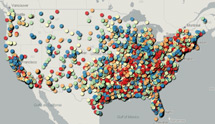Auto logout in seconds.
Continue LogoutThe Joint Commission last week published a list of the five requirements hospitals and other health care organizations were most likely to miss in 2017.
Get the cheat sheets: How hospital quality ratings programs work
According to the Joint Commission, the list is based on a review of its hospital accreditation and certification surveys conducted in 2017.
Top 5 requirements hospitals did not comply with
The top 5 hospital accreditation requirements most likely to be cited as "not compliant" in 2017 were:
- Provides and maintains systems for extinguishing fires, for which 86% of hospitals were not compliant;
- Manages risks associated with a hospital's utility systems, for which 73% of hospitals were not compliant;
- Provides and maintains building features to protect individuals from the hazards of fire and smoke, for which 72% of hospitals were not compliant;
- Reduces the risk of infections associated with medical equipment, devices and supplies, for which 72% of hospitals were not compliant;
- Established and maintains a safe, functional environment, for which 70% of hospitals were not compliant.
For critical access hospitals (CAHs), the top 5 accreditation requirements most likely to be cited as "not compliant" in 2017 were:
- Manages risks associated with hospital utility systems, for which 85% of CAHs were not compliant;
- Provides and maintains systems for extinguishing fires, for which 83% of CAHs were not compliant;
- Reduces the risk of infections associated with medical equipment, for which 72% of CAHs were not compliant;
- Building and fire protection features are designed and maintained to minimize effects of fire, smoke, and heat, for which 70% of CAHs were not compliant;
- Inspects, treats and maintains medical gas and vacuum systems, for which 69% of CAHs were not compliant.
Top 5 accreditation misses for other organizations
The Joint Commission also published the top 5 accreditation requirements most likely to be cited as "not compliant" in 2017 for ambulatory care and home care providers.
For ambulatory care providers, the top five were:
- Reduces the risk of infections associated with medical equipment, devices, and supplies, for which 60% of ambulatory care providers were not compliant;
- Safely stories medications, for which 49% of ambulatory care providers were not compliant;
- Grants initial, renewed, or revised clinical privileges to individuals who are permitted by law and the organization to practice independently, for which 47% of ambulatory care providers were not compliant;
- Inspects, treats, and maintains medical equipment, for which 38% of ambulatory care providers were not compliant;
- Manages risks associated with its utility systems, for which 38% of ambulatory care providers were not compliant.
For home care providers, the top five were:
- Provides care, treatment, or services in accordance with orders or prescriptions, as required by law and regulation, for which 42% of home care providers were not compliant;
- Plans patient care, for which 41% of home care providers were not compliant;
- Implements planned infection prevention and control activities, for which 34% of home care providers were not compliant;
- Staff who are competent to perform their responsibilities, for which 32% of home care providers were not compliant;
- Patient record contains information that reflects the patient's care, treatment, or services, for which 29% of home care providers were not compliant (Vaidya, Becker's Clinical Leadership & Infection Control, 4/17; Joint Commission article, 4/11).
Get the cheat sheets: How hospital quality ratings programs work
Download our one page sheets for summaries on the methodology and metric categories used in five hospital quality rating programs:
Don't miss out on the latest Advisory Board insights
Create your free account to access 1 resource, including the latest research and webinars.
Want access without creating an account?
You have 1 free members-only resource remaining this month.
1 free members-only resources remaining
1 free members-only resources remaining
You've reached your limit of free insights
Become a member to access all of Advisory Board's resources, events, and experts
Never miss out on the latest innovative health care content tailored to you.
Benefits include:
You've reached your limit of free insights
Become a member to access all of Advisory Board's resources, events, and experts
Never miss out on the latest innovative health care content tailored to you.
Benefits include:
This content is available through your Curated Research partnership with Advisory Board. Click on ‘view this resource’ to read the full piece
Email ask@advisory.com to learn more
Click on ‘Become a Member’ to learn about the benefits of a Full-Access partnership with Advisory Board
Never miss out on the latest innovative health care content tailored to you.
Benefits Include:
This is for members only. Learn more.
Click on ‘Become a Member’ to learn about the benefits of a Full-Access partnership with Advisory Board
Never miss out on the latest innovative health care content tailored to you.

